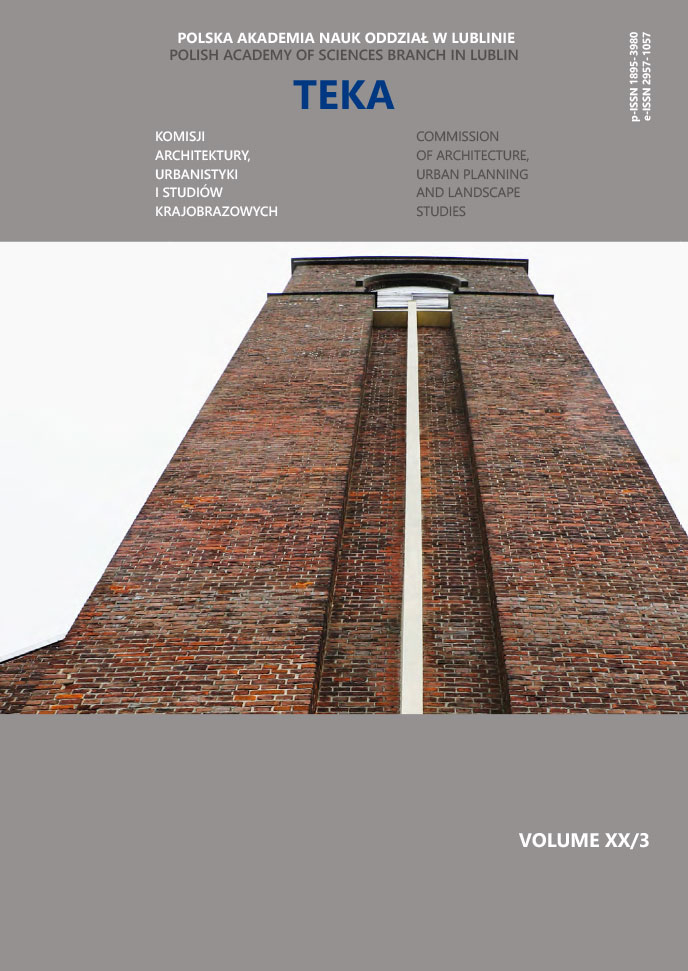Evaluation of remote learning at technical universities during a pandemic – the perspectives for the future
Dariusz Gaweł
dga@vp.plKatedra Architektury Współczesnej, Wydział Budownictwa i Architektury, Politechnika Lubelska (Polska)
https://orcid.org/0000-0001-5759-1962
Abstrakt
This article is a summary of a research conducted in the conditions of remote teaching of undergraduate and postgraduate students at technical university. The research referred to the effectiveness and perspectives of web-based education (under the conditions of lockdown) during the COVID-19 pandemic. The aim of the research was to assess the quality of courses and involvement of students in the learning process. One year after the introduction of this form of learning at universities, certain phenomena can be observed, which allow us to draw the first conclusions. In the final part of the study, the author discusses the possibility to continue and use this form of education once the pandemic has passed. The familiarisation and adaptation of students to this specific character of courses in the conditions of a pandemic was a stimulus to interpret this state as a long-term form of education that can change future ways and forms of teaching at universities, including technical universities
Słowa kluczowe:
remote learning, technical universities, pandemic Covid 19, LUTBibliografia
Bao W., Covid-19 and online teaching in higher education: A case study of Peking University. Human, Behavior and Emerging Technologies, Waley Online Library, 2020, 2, 2, 113−115.
DOI: https://doi.org/10.1002/hbe2.191
Google Scholar
Frederick F., Cartwright M., Niewidoczny wróg. Zarazy i historia, Jakość Wiedzy, Warszawa 2002 (in Polish).
Google Scholar
Colombo F., The mental Health Impact of Covid-19, Global Parliamentary Network, OECD(2021), 16 April 2021, http://oecd.org/parliamentarians/meetings/gpn-meeting-february-2021/Francesca-Colombo-The-Mental-Health-Impacts-of-COVID-19-10-02-2021.pdf
Google Scholar
Kaliszewska-Czeremska K., Matejczuk J., E-learning jako nowe środowisko edukacji: spotkanie ucznia i nauczyciela, Studia Edukacyjne, 27, 219−236, Uniwersytet im. Adama Mickiewicza w Poznaniu, Poznań 2013 (in Polish).
Google Scholar
Jasiołek A., Nowak P., Brzezicki M., On-line, face-to-face or hybrid teaching in architectural education?, World Trans. on Engng. and Technol. Educ., 2021, 19, 1, 90−95.
Google Scholar
Makowska B.,Teaching freehand drawing on-line to architecture students, World Trans. on Engng. and Technol. Educ., 2021, 19, 1, 41−47.
Google Scholar
Białkiewicz A., Architectural competitions support student creativity, World Trans. on Engng. and Technol.Educ., 2020, 18, 2, 157−162.
Google Scholar
Zieliński R., New technologies to support students in a BIM design course, World Trans. on Engng. and Technol.Educ., 2020, 18, 3, 313−317.
Google Scholar
Białkiewicz A., Aspects of teaching architecture in the context of educators’ professional experience, World Trans. on Engng. and Technol. Educ., 2019, 17, 3, 244−249.
Google Scholar
Wybrane wyniki oceny kształcenia na odległość realizowanego w semestrze letnim roku akademickiego2019/2020 dokonanej przez studentów, Politechnika Lubelska 2020, 16 April 2021 (in Polish), http://weii.pollub.pl/files/70/content/files/25948_Wybrane,wyniki,pracowniczej,oceny,zdalnego,ksztalcenia.pdf.
Google Scholar
Bijas K., Gerłowska J., Góra K., Korniluk A., Kurtyka J., Ledwoń A., Nadzieja-Dziubek J., Students’ Welfare during SARS-CoV-2 Pandemic, Annales Universitatis Mariae Curie – Skłodowska, Maria Curie-Skłodowska University in Lublin, Faculty of Pedagogy and Psychology, 2020, 33, 3, 261−278.
DOI: https://doi.org/10.17951/j.2020.33.3.261-278
Google Scholar
Kobylarczyk J., Kuśnierz-Krupa D., Methods of teaching students versus their preparedness for work asarchitect engineers, World Trans. on Engng. and Technol. Educ., 2020, 18, 3, 278−283.
Google Scholar
Autorzy
Dariusz Gawełdga@vp.pl
Katedra Architektury Współczesnej, Wydział Budownictwa i Architektury, Politechnika Lubelska Polska
https://orcid.org/0000-0001-5759-1962
Statystyki
Abstract views: 278PDF downloads: 107
Licencja

Utwór dostępny jest na licencji Creative Commons Uznanie autorstwa – Na tych samych warunkach 4.0 Miedzynarodowe.




